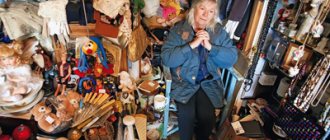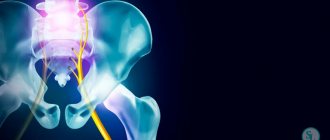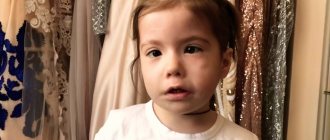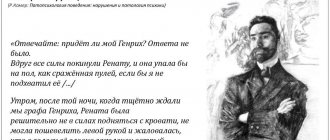One of the forms of obsessive behavior, which is characterized by the desire to accumulate things, is called “Plyushkin syndrome” at the everyday level, and in psychiatry – pathological hoarding.
Other synonyms are also used: syllogomania or hoarding. The irrational desire to preserve any things, including those not suitable for later use, has been known for a long time; it is considered a sin in Christianity, and in the Church Slavonic language it is called molestation. In modern speech (mainly among the Russian-speaking population), this disorder is associated with a literary hero - Stepan Plyushkin, one of the characters in the work “Dead Souls” by Nikolai Vasilyevich Gogol.
Signs of Plyushkin syndrome
People who develop Plyushkin syndrome (pathological hoarding) keep old things even when they are of no value. These items may be dilapidated, beyond repair, and cannot be used in any way in the future. However, a person who exhibits signs of Plyushkin syndrome is not able to get rid of them.
For such people, the need to throw away some low-value, broken or unnecessary thing, or even the thought of the possibility of such an action, causes a feeling of pronounced anxiety and brings significant discomfort. Therefore, people with Plyushkin syndrome keep everything; over time, the accumulated property becomes nowhere to be stored, but this circumstance does not affect the behavior of patients with pathological hoarding. Unnecessary, old, broken or dilapidated objects clutter up the entire space, and the apartment or house becomes uninhabitable.
The housing of people with Plyushkin syndrome is completely filled with unnecessary things, even garbage: there is no place for cooking on the kitchen surfaces, the doors to the bathrooms cannot be closed due to the accumulated rubbish, bags or sacks are hung on the walls, the floor is completely cluttered, and there are only narrow passages , children do not have space to play and develop.
People suffering from Plyushkin syndrome often hide their obsessive actions from relatives and friends and do not invite them home. They are embarrassed by cluttered housing, and they have difficulty inviting workers to repair the premises, a doctor or guests.
Very often, stacked useless things pose a serious threat - they can become breeding grounds for parasites, the fire safety of housing is reduced, and escape routes in case of fire are difficult.
Individuals who have signs of Plyushkin syndrome find a rational explanation for their actions even if pathological hoarding reaches a significant degree of severity.
Pathological hoarding is different from thrift and collecting. With Plyushkin syndrome, things are usually stored in disarray and litter the space; they are of no value and are not used for construction or repair. In addition, this disorder is not analogous to shopaholism, in which a state of satisfaction is achieved by acquiring a new thing, even if it is not needed. With pathological hoarding, a person cannot throw away anything, and a shopaholic easily parts with objects.
It is necessary to distinguish between pathological hoarding and the one-time appearance of a large number of things and rubbish (for example, after a person receives an inheritance), since the signs of Plyushkin syndrome persist for a long time.
Pathological hoarding can take on various forms, but a combination of them is also possible.
Pathological accumulation of one's belongings
A person with pathological hoarding cannot part with his things even after they cease to be of any value. It stores not only worn-out clothes or broken equipment, but also newspapers, rags, bottles of household chemicals, plastic bags, etc.
Collecting discarded items
In this form of the disorder, a person picks up unnecessary items from trash heaps, brings them into his home and stores them indefinitely, without sorting or using them. Collecting discarded things usually meets with rejection from loved ones, but a person cannot resist it.
Pathological hoarding of animals
One of the varieties of Plyushkin syndrome also includes pathological hoarding of animals, when people have an excessively large number of pets without being able to provide them with the necessary nutrition and veterinary care. This form of the disorder is the most dangerous for both the collectors themselves and their neighbors, as it leads to non-compliance with sanitary standards and a high likelihood of developing zoonotic infectious diseases.
Covid as trauma
Specialists from the National Medical Research Center named after. V. M. Bekhterev believes that after COVID-19, patients experience symptoms characteristic of the so-called post-traumatic stress disorder (PTSD).
PTSD is a mental disorder that occurs after events that have a traumatic effect on the individual’s psyche. At the same time, the traumatic nature of the events that occurred is associated with a person’s feeling of helplessness, the inability to influence what is happening, and to resist danger. Characteristic symptoms of PTSD include flashbacks, nightmares, partial amnesia, emotional instability and panic attacks. These manifestations can occur not only immediately after a traumatic event, but also months and even years later.
PTSD is well known to psychiatrists - this disorder can occur after any event that traumatizes the individual’s psyche. And Covid may well be one of them.
Photo © Pixabay
Diagnostic criteria for Plyushkin syndrome
Pathological hoarding disorder is a chronic disorder. At the moment, Plyushkin syndrome is not included as a separate nosological unit (disease) in modern classifiers, although the medical community is considering the need to indicate this disorder in the next, eleventh, edition of the ICD.
To determine the disorder, the following diagnostic criteria for Plyushkin syndrome are used:
- The need to throw away or give away things that are not even of real value to someone causes significant difficulties.
- A feeling of a strong need to preserve things and discomfort at the suggestion that they need to be gotten rid of.
- Accumulating property clutters living and utility rooms, so these spaces cannot be used for their intended purpose.
- A pathological tendency to keep unnecessary things creates discomfort and leads to problems in social, everyday, professional and other areas of activity.
Wrong parenting model
The character of a shopaholic is filled with undesirable traits. Among them -
- poor resistance to stress;
- inadequate self-esteem;
- increased suggestibility;
- egocentrism;
- hypertrophied anxiety;
- hypersensitivity;
- reduced adaptive capacity;
- emotional imbalance.
These personality traits are formed under the influence of improper upbringing . Two of its models are fatal.
The first involves raising a child like a family idol. They pamper him and buy him everything he wants. Usually such children, and then adults, are capricious, selfish, and emotionally unstable. Shopaholics of this kind have been spoiled by attention since childhood. Having no special abilities, they attract attention to themselves by ostentatiously spending money. They buy expensive but useless goods. Their spending is thoughtless, they easily spend all their money.
The second model of education is like Cinderella. These are children of authoritarian parents, who have been accustomed to a harsh, strict attitude since childhood. They lack love, attention, affection, care, recognition. “Cinderellas” feel abandoned, useless to anyone. In childhood, such people were subject to excessive demands. They were taught to strictly adhere to the rules without the possibility of departure, and Spartan education was used.
Through multiple purchases, Cinderella oniomaniacs try to compensate for the lack of parental love and, possibly, material wealth. If no one loves them, then they probably love themselves and will buy anything for themselves, their loved ones. If “Cinderellas” are trying to make up for what they were deprived of in childhood, then such individuals do not choose nonsense, but acquire more practical things.
Star shopaholics include Victoria Beckham and Sarah Jessica Parker. Victoria can spend up to 150 thousand dollars in 1 day. Once the star purchased glasses worth 25 thousand dollars, and then lamented that she had made an absolutely useless purchase. But her main passion is Hermes bags. She has about a hundred of them.
Sarah Jessica Parker, like her character in the TV series Sex and the City, loves shoes. Her arsenal includes both very expensive models and cheap ones, costing $100. In total, the star has about a hundred pairs of all kinds of shoes and boots. Sarah admits that she can't pass by a pair of shoes she likes.
Reasons for the development of Plyushkin Syndrome
The scientific community currently identifies a number of factors that may contribute to the occurrence of Plyushkin syndrome (pathological hoarding).
There is an opinion that often the tendency to develop Plyushkin syndrome manifests itself after serious life shocks, such as the destruction of a family, a serious illness or the loss of someone close. Tragic events play the role of a primary incentive to save things of a loved one for sentimental purposes, but over time, compulsive hoarding spreads to other items and takes on a sustainable character.
There are studies that prove the neuroanatomical basis for the formation of this disorder. Such publications mention the structural features of the brain in people suffering from Plyushkin syndrome, namely: poor development of the frontal lobe cortex, especially the right hemisphere - that is, those structures that control the rationality of actions.
It is worth noting that caring for material well-being is a psychological priority to a greater extent for older people. Therefore, they become more susceptible to pathological hoarding. The presence of mental illness, especially mental retardation or decreased intelligence of vascular or atrophic origin, can be a significant predisposing factor. Other deficiency conditions in endogenous (schizophrenia) or organic diseases may also be important in the development of Plyushkin syndrome.
Also, factors that can contribute to the formation of the disorder include a history of a traumatic situation, the loss of a loved one significant to the patient, loneliness and the influence of past illnesses or surgical intervention.
Studies explaining the reasons for the development of Plyushkin syndrome are few, and there is no clear answer to the question about the factors in the formation of the disorder.
What it is
Oniomania is a widespread form of addictive, that is, dependent, behavior. From Greek the term is literally translated as onios - “for sale” and mania - “madness”. Among the people, the concept is known to almost every person under the name “shopaholism.”
Currently, there is debate among experts on the topic: “Is shopaholism a disease?” In fact, officially such a disease does not exist. It is not listed in the International Classification of Diseases. This gives grounds for some scientists to classify shopping addiction as a fashion trend or consider it a sign of weakness, the same as, for example, when a person cannot overcome a craving for sweets.
But studies have confirmed that at the biochemical level in the body, with oniomania, the same changes occur as with any addiction: drugs, alcohol, gambling. Consequently, such a bad habit as shopaholism is rightfully considered one of the forms of addictive behavior. This is a real mental disorder with all the ensuing negative consequences, which only a professional can cure.
The history of shopaholism as a separate disease began in the 19th century. Then the first symptoms of the disorder were described by the famous German psychiatrist Emil Kraepelin together with his Swiss colleague Eugen Bleuler.
One of the famous shopaholics is Barbara Zelinski, who in 1956 announced the main tenets of a true shopper:
- whoever gets up early will visit more shops;
- not buying the right thing will harm your health;
- We won’t stand behind the price.
Barbara is called the founder of shopping. She set a world record: a woman managed to spend her husband’s salary in 1 minute 55 seconds. The husband, unable to bear the “hobby” of his beloved, eventually divorced her.
Treatment of Plyushkin syndrome
In most cases, people suffering from pathological hoarding do not consider their actions as abnormal. As a rule, loved ones and neighbors experience great inconvenience from collecting and storing unnecessary things. Lack of criticism of one’s condition and its consequences is a serious obstacle in the treatment of Plyushkin syndrome.
Patients themselves rarely seek medical help. Usually the initiative comes from those relatives who live with the patient.
Drug treatment
There are essentially no official protocols for the treatment of Plyushkin syndrome. Some studies indicate some success with therapies such as antidepressants. But drug treatment of pathological hoarding does not show satisfactory effectiveness.
Anxious expectations
Already in the first wave of the pandemic in 2021, psychiatrists drew attention to changes in the mental health of the population. Lockdowns, other coronavirus restrictions, remote work, a person constantly being at home - all this has already provoked negative psychological effects. Add to this anxious expectations - fear of becoming seriously ill, fear for loved ones, the possibility of losing a job - and here it is, a set that places a heavy burden on the human psyche.
At the same time, some researchers have started talking about the increase in suicidal and depressive feelings among completely healthy citizens in different countries of the world. Moreover, data began to appear about increasing cases of domestic violence and divorce.
Photo © Pixabay
When a person gets sick, his anxious expectations intensify. The patient begins to monitor his condition, symptoms, temperature, and breathing with fear. No one wants to end up in a hospital under strict quarantine. Even more fears are caused by the possibility of developing severe complications, the use of ventilators and other procedures. Now doctors already know that the most severe psychological consequences occur precisely in patients who have undergone artificial ventilation.









